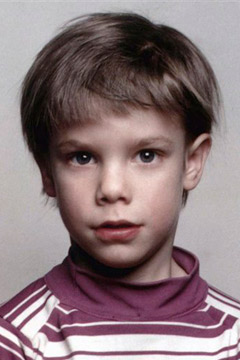
This undated file photo provided by Stanley K. Patz shows his son Etan who vanished on May 25, 1979, and has never been found.
After 33 years, New York police have once again renewed their investigation into the disappearance of Etan Patz, the 6-year-old boy who went missing after leaving his family’s SoHo apartment to catch a bus to school. On Thursday, investigators began excavating a New York basement after an FBI dog detected human remains, the AP reports. Patz’s disappearance on May 25, 1979 shook the U.S., drawing national attention to the plight of missing children and acting as a catalyst for better legislative, financial and social efforts to recover them.
(MORE: Etan Patz: FBI Searches New York Basement for Sign of First Missing ‘Milk Carton’ Boy)
A series of tragic kidnappings, including Patz’s and 29 missing and murdered children in Atlanta, Georgia, prompted Ronald Reagan to create the National Center for Missing and Exploited Children and proclaim May 25 ‘National Missing Children’s Day,’ in 1983. Patz’s father, a professional photographer, mobilized attention by dispersing photographs of the missing boy. By the early 80s, Patz’s blonde hair and big smile became the first of many children to grace the side of a milk carton in the U.S.
Organized by the NCMEC, the milk carton ‘missing children’ campaign began with local dairies in the Midwest in a pilot program that lasted about six months. “What it did was raise the level of awareness,” Noreen Gosch, whose missing son, Johnny, also appeared on milk cartons, told the AP. “It didn’t necessarily bring us tips or leads we could actually use.”
Missing children appeals showed up on milk cartons across the nation throughout the ’80s, but by the end of the decade, the program began to fade out, primarily due to concerns over its efficacy and complaints by pediatricians that the photos frightened young children. “People weren’t really paying attention to the images on the milk cartons,” the center’s Bob Lowery told the San Jose Mercury News. “The only ones paying attention were younger children enjoying their cereal.”
(MORE: A Young Boy’s Murder Has Parents Second-Guessing Their Decisions)
The milk campaigns helped the center recover children at a rate of 62 percent during its inaugural year in 1984. Since then, NCMEC has assisted law enforcement with more than 182,000 missing-child cases, resulting in the recovery of more than 169,000 children, a rate of 92%. “It’s because of better awareness of missing children and also our ability to connect through social media, Amber alerts and all the tools we have,” Lowery told the Mercury News.
But while the milk carton pictures may have been a failure, they’ve become indelible pop-culture shorthand for missing persons, figuring (seriously) in the plot of young adult novels and (hilariously) in the Eminem video for ‘The Real Slim Shady’. But with milk carton appeals off the table for some time, campaigns to find missing children have gotten a little more high tech. According to the Mercury News, Facebook, Twitter and QR codes are now common tools harnessed to find lost children. QR codes on posters have become especially popular, thanks to their ability to link directly to websites, and embed photos, information and phone numbers. “It essentially makes the missing poster portable,” says Stephen Watkins, who works with Child Quest International, a nonprofit missing children’s agency, and came up with the idea.
Thanks to the ease of information sharing, missing children come home safely today more than any other time in the nation’s history. Still, there’s a ways to go in protecting children. The U.S. Department of Justice reports roughly 800,000 children younger than 18 years old are reported missing each year.






